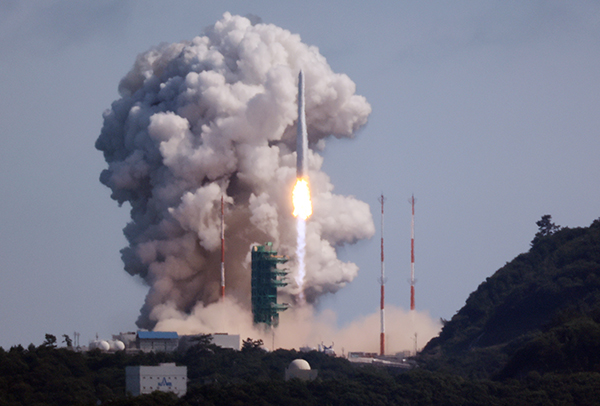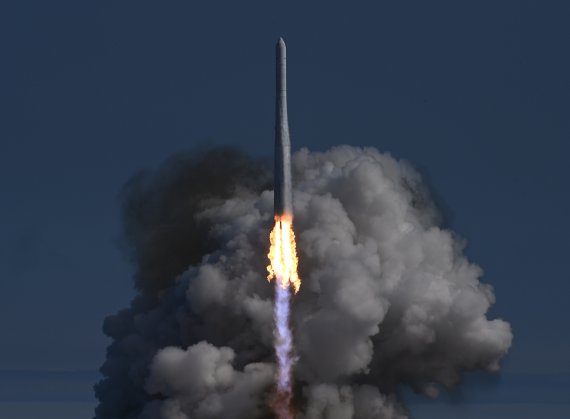Abstract: The successful launch of the Korean Space Launch Vehicle (KSLV)-2 Nuri rocket might be considered a technical stepping stone for South Korea to become capable of developing an inter-continental ballistic missile. The rocket is similar in structure to a ballistic missile and was developed with almost the same aerospace engineering technology. Even though the civilian rocket is claimed not to be intended for military purposes, it might cause tensions with North Korea and China. South Korea would likely be able to complete an ICBM after more launches of more advanced Nuri rockets by 2031.
Problem statement: How to understand and interpret the recent launch of the Nuri rocket from the perspective of South Korea’s security interests?
Bottom-line-up-front: Nuri’s success has proved to the world that South Korea now has the potential to develop an indigenous ICBM in response to North Korean and Chinese threats.
So what?: Even though South Korea did not fully acquire all required technologies for an ICBM, Seoul needs to expedite the acquisition of strategic assets, including ICBM, long-range SLBM, and ISR (intelligence, surveillance and reconnaissance) satellites based on space technology accrued by its space rockets so far.

Source: opensource/KARI
Conceptually an ICBM?
A suspicion was once raised when the first Nuri rocket launch failed last October.[1] A mockup satellite payload was attached to the rocket to simulate a re-entry as if it was a warhead from a test of an Inter-Continental Ballistic Missile (ICBM) falling near the southern sea of Australia. The Nuri launch vehicle flew 8,100 km until the fall to the sea, which was already equivalent to the firing range of an ICBM. The rocket had a guided navigation system typically installed on ballistic missiles to decide a target and detonation time, igniting more suspicion. The Korea Aerospace Research Institute (KARI) quickly sought to settle the controversy by explaining that the mockup fell at a low speed and that Seoul does not possess ICBM-related knowledge.
South Korea’s KSLV-II (Korea Space Launch Vehicle) ‘Nuri’ was successfully launched in June 2022, making South Korea the seventh country in the world to have independent satellite launch capability. Notably, although South Korea has emphasised that Nuri was designed for civilian use, it seems that Nuri could also serve as a technical basis for a South Korean Inter-Continental Ballistic Missile (ICBM) in the future
South Korea’s KSLV-II (Korea Space Launch Vehicle) ‘Nuri’ was successfully launched in June 2022, making South Korea the seventh country in the world to have independent satellite launch capability.
Technologies used in the Nuri rocket are more advanced than those of North Korea; Seoul’s rocket weighs 200 tonnes with a three-stage rocket body, and the first stage has adopted a clustering method that generates 300 tonnes of thrust.[2] Also, its structure is identical to the North Korean ICBM Hwasung-17.[3] Although the North Korean ICBM’s engine thrust is rated around 160 tonnes, its maximum firing range is already estimated to be 15,000 km.[4], [5] This implies that Seoul’s Nuri rocket could fly farther in terms of its strike range if the acquired technology is used for military applications.
Heat-Resistance and Re-Entry Capability
Of course, it is true that the civilian Nuri rocket and a military ICBM theoretically share very similar aspects. As the KARI has already explained, the rocket cannot be immediately turned into a strategic strike asset like Intermediate Range (IRBM) or Inter-Continental Ballistic Missiles. However, it is also true that the success of the Nuri rocket was a cornerstone in the advancement and acquisition of commonly necessary launch technologies such as a combination of several bodies, engine, propulsion, structure, navigation and speed control systems, etc.
The two key differences between a civilian space rocket and a ballistic missile are heat resistance and the atmospheric re-entry ability that makes it possible for payloads to re-enter the atmosphere, which only requires more technical delicacy. Thus, it would be only a matter of time for Seoul to acquire an ICBM if the security situation around the Korean Peninsula worsens[6]. The primary purpose of Seoul’s future ICBM would be to deter China by potentially targeting its entire territory — not to mention North Korea. Covering the entire Chinese mainland requires a firing range of more than 5000 km, and South Korea currently possesses the latest Hyunmoo-4 ballistic missile with a maximum of only 800 km. Its cruise missiles, such as Hyunmoo 3-C or D, are ineffective deterrents as they have limited payloads and flying speed. Meanwhile, the Chinese conventional and nuclear missile arsenal already targets all significant cities and military facilities in South Korea. This is a problem to which Seoul has had no effective countermeasures based on equivalent strikes due to the ROK-US missile guideline, which were in place until May 2020.
The primary purpose of Seoul’s future ICBM would be to deter China by potentially targeting its entire territory — not to mention North Korea.
As the Nuri rocket uses liquid fuel that takes quite a long time to launch, it may not be a functional ICBM by itself, even though South Korea could adopt liquid fuel for an ICBM as North Korea has done so far for its Hwasung series of ICBMs. However, the technology and experiences gained from Nuri would make the technological leap to IRBM/ICBMs much smaller.

Source: opensource/KARI
South Korea may be concerned that a liquid fuel-based ICBM would be vulnerable to preemptive or preventative strikes. Due to its large size and time-consuming fueling process, an enemy’s surveillance or reconnaissance assets could spot the preparation of the missile. Therefore it is unlikely that Seoul will choose to convert the current Nuri rocket into a ballistic missile—at least until the South Korean military launches easier and faster solid propellant space rockets in 2024. The first test launch of a large solid-fuel propulsion system verified its performance and core technologies last year.[7] Notwithstanding the military-strategic fact that a liquid fuel-based space rocket does not make a practical ballistic missile—and Seoul’s preference for solid propellant rockets—it is vital to remember that even though South Korea refers to Nuri as a non-military asset, it is an almost identical system when compared to North Korea’s ‘Hwasung’ series of liquid-fuelled ICBMs.[8] It is well-known that there is not much technical difference in general between a space rocket and an ICBM.
To put it more simply, a space rocket loaded with a warhead is a weapon, while one loaded only with a satellite for space exploration is not. The Soviet Union’s R7 missile in the 1960s was an example of an ICBM that became a civilian space-launch vehicle, as was the US Titan II. In the reverse order, North Korean long-range rockets such as ‘Baekdusan’, ‘Unha, and ‘Kwangmyongsong’ launched between the late 1990s and the mid-2010s also transformed into Hwasung ICBMs, such as Hwasung-14 (KN-20) and 15 (KN-22) underscoring the fact that Rockets and ICBMs are largely interchangeable.[9]
A Non-Nuclear State with ICBMs?
As American and Japanese media outlets put a question mark on the Nuri as an ICBM, South Korea faces China and North Korea enhancing nuclear strike capabilities. In response to the growing threats of Pyongyang and Beijing—intentionally or not— the Nuri rocket has tacitly delivered a warning to those states that Seoul has the potential to significantly lengthen the range of its Hyumoo ballistic missiles and acquire satellite-based intelligence-gathering and surveillance systems.
Since the strict Republic of Korea-U.S. missile guideline was terminated in 2021[10], increasing the missile arsenal will continue—no matter which political party wins the presidency—by applying Seoul’s accrued rocket technology. South Korea could then arguably be the first non-nuclear state to possess advanced ballistic missiles in terms of firing range. Even if it only acquired an Intermediate-Range Ballistic Missile (IRBM) capability with a maximum range of 3,000-5,000 km, it would cover all of North Korea and China. The main technical problem left to solve would be developing a re-entry vehicle.
South Korea could then arguably be the first non-nuclear state to possess advanced ballistic missiles in terms of firing range. Even if it only acquired an Intermediate-Range Ballistic Missile capability with a maximum range of 3,000-5,000 km, it would cover all of North Korea and China.
Since any ballistic missile that could hit a target over 5000km is traditionally considered inter-continental, the South Korean ICBM would not necessarily have to be able to fly more than 8000 km. A South Korean ICBM would be shorter than those of Russia or the US, with a range between 5000-7000km. This would best serve the security interests of South Korea because the country doesn’t have any more severe threats than China and North Korea. The specifically announced firing range directing only towards China and North Korea would also help address the world’s possible concern that South Korea might transform itself into a global threat that might target other countries.
First- and Second-Strike Capability
Nuri is not only a means to launch constellations of intelligence, surveillance, reconnaissance (ISR) assets and communication satellites, as announced by the Korean Aerospace Research Insitute[11], but it is also a de facto universal announcement of long-range missile development. For now, not only the NPT (Non-proliferation Treaty) regime but also the US-Republic of Korea (ROK) Agreement for Peaceful Nuclear Cooperation still prevents Seoul from going nuclear[12]. NPT-signed states naturally have the exit right based on Article X that enables them to withdraw from the treaty in case where their national security interests are in danger[13], but the Washington-led bilateral nuclear agreement is more binding to Seoul due to its deep diplomatic relations with the key ally United States, and the White House is not willing to lift the bar yet. It is thus highly likely that South Korea would first adopt conventionally-armed ICBMs as the non-nuclear country has deployed the submarine-launched ballistic missile (SLBM) Hyunmoo 4-4 with conventional warheads for the first time in the world unless either North Korean and Chinese nuclear bombs are more advanced earlier than expected or the issue of violating the bilateral nuclear agreement is handled properly by modifying or abolishing the two countries’ nuclear agreement.
Given that the security situation of South Korea is compromised by the expected upgrade of the Chinese forces and North Korea’s nuclear advancement, Seoul is most likely to need both the first and second strike capabilities whether it adopts a tit-for-tat strategy by going nuclear or not —irrespective of the South Korean government’s insistence on the supposedly civilian-only nature of the Nuri rocket. To enhance a second-strike capability, the road-mobile TEL that the South Korean Army already operates[14] for Hyumoo variants could be used for its long-range missile if Seoul decides to possess ICBM in the future. Larger submarines which will be acquired by the late 2030s could also accommodate a naval variant of the ICBM if South Korea makes such a decision.
Seoul is most likely to need both the first and second strike capabilities whether it adopts a tit-for-tat strategy by going nuclear or not.
The abolished missile guideline that had limited South Korea’s missile development so far[15] and the use of advancing South Korean space technology for security purposes are expected to deter North Korea and China as a means of alliance-based expanding security cooperation with Washington.[16] Thus, these make it likely that Nuri could serve as the basis for a South Korean long-range missile system.
Daehan Lee is a political and security affairs researcher regularly writing for Defense News and Naval News. He previously worked for the U.S. and Belgian embassies in Seoul, the People Power Party, and election camps. Lee also served as a translator for the Republic of Korea Navy. His interests are Asia-Pacific security, (non)proliferation, defence acquisition, inter-Korean affairs, South Korean politics and foreign policy. The views in this article are the author’s alone and do not represent the views of the Defence Horizon Journal.
[1] “Nuriho vs Hwaseong-17 Type… What Is the Performance Difference?,” Teller Report, March 26, 2022.
[2] “Nuri, the Korean Launch Vehicle,” Korea Aersopace Research Institute (KARI), accessed July 18, 2022.
[3] Sammi Pitz, “North Korea Unveils Two New Strategic Missiles in October 10 Parade,” 38 North, October 10, 2020.
[4] “Nuriho vs Hwaseong-17 Type… What Is the Performance Difference?,” Teller Report, March 26, 2022.
[5] “24 March 2022 DPRK ICBM Test,” Open Nuclear Network, Accessed July 18, 2022.
[6] Timothy Wright, “Review of US and South Korea Scrap Ballistic-Missile Range Limits,” International Institute for Strategic Studies (IISS), June 2, 2021.
[7] Mark Zastrow, “WATCH: South Korea Tests Solid-Fuel Rocket with Sea Launch,” Astronomy, April 13, 2022.
[8] John Schilling, “Satellites, Warheads and Rockets: Is North Korea’s Space Program Really about Missile Development?,” 38 North, February 5, 2016.
[9] Michael Elleman, “Prelude to an ICBM?? Putting North Korea’s Unha-3 Launch Into Context,” Arms Control Association, 2022.
[10] “U.S.-ROK Leaders’ Joint Statement,” The White House, May 22, 2021.
[11] Korea Aersopace Research Institute (KARI), “Future Vision 2050,” accessed July 18, 2022, https://www.kari.re.kr/eng/sub01_06.do.
[12] “U.S.-Republic of Korea (ROK) Agreement for Peaceful Nuclear Cooperation,” Bureau of International Security and Nonproliferation of the U.S. Department of State, accessed July 24, 2022.
[13] “Treaty on the Non-Proliferation of Nuclear Weapons (NPT),” Office for Disarmament Affairs of the United Nations, accessed July 24, 2022.
[14] “Hyunmoo 2-C,” Missile Threat of the Center for Strategic and International Studies (CSIS), accessed July 18, 2022.
[15] Sang-min Kim, “U.S. Lifts Missile Limits on Korea,” Arms Control Association, June, 2021.
[16] Haye-ah Lee, “Yoon vows to expand S. Korea’s role based on alliance with U.S.,” Yonhap News Agency, July 3, 2022.





